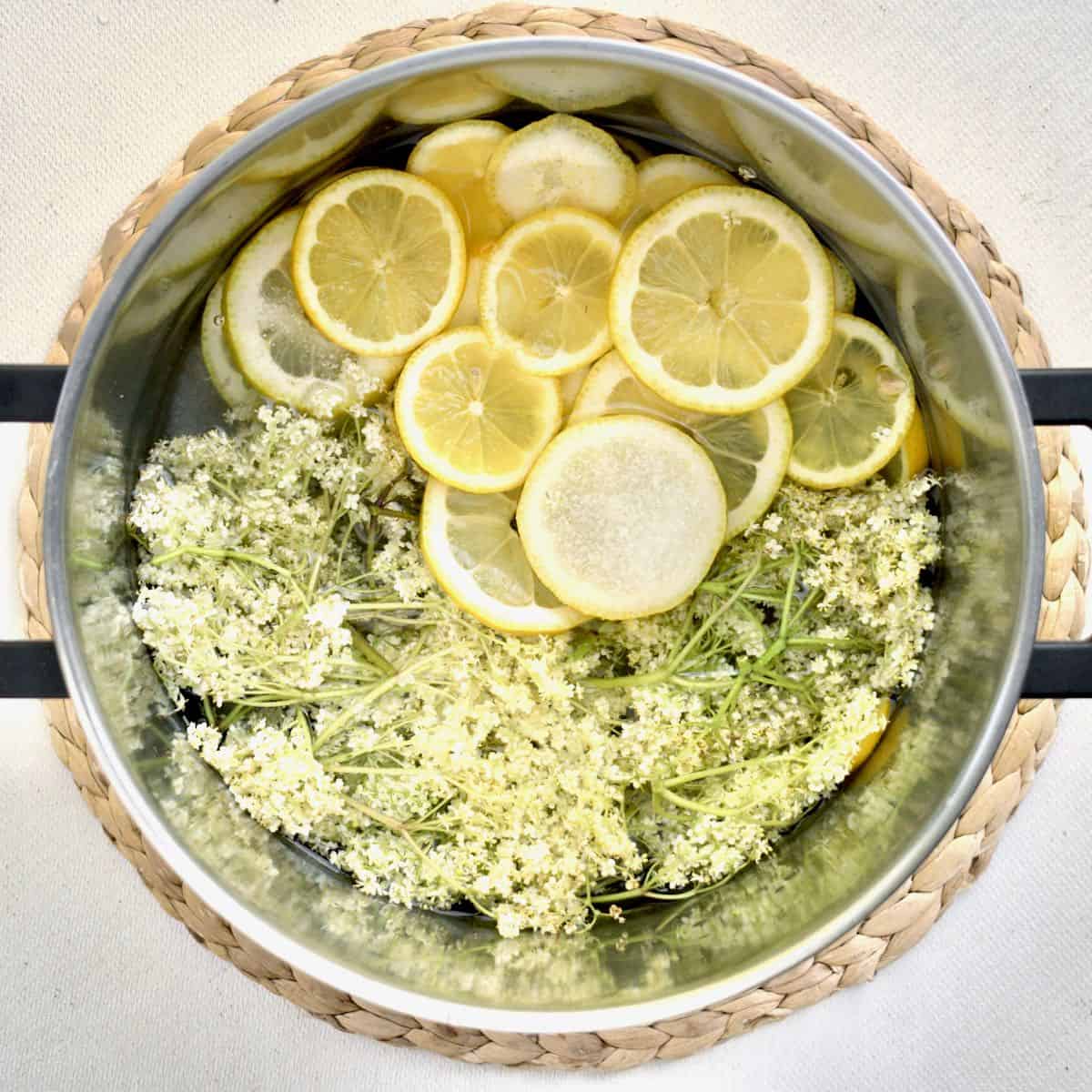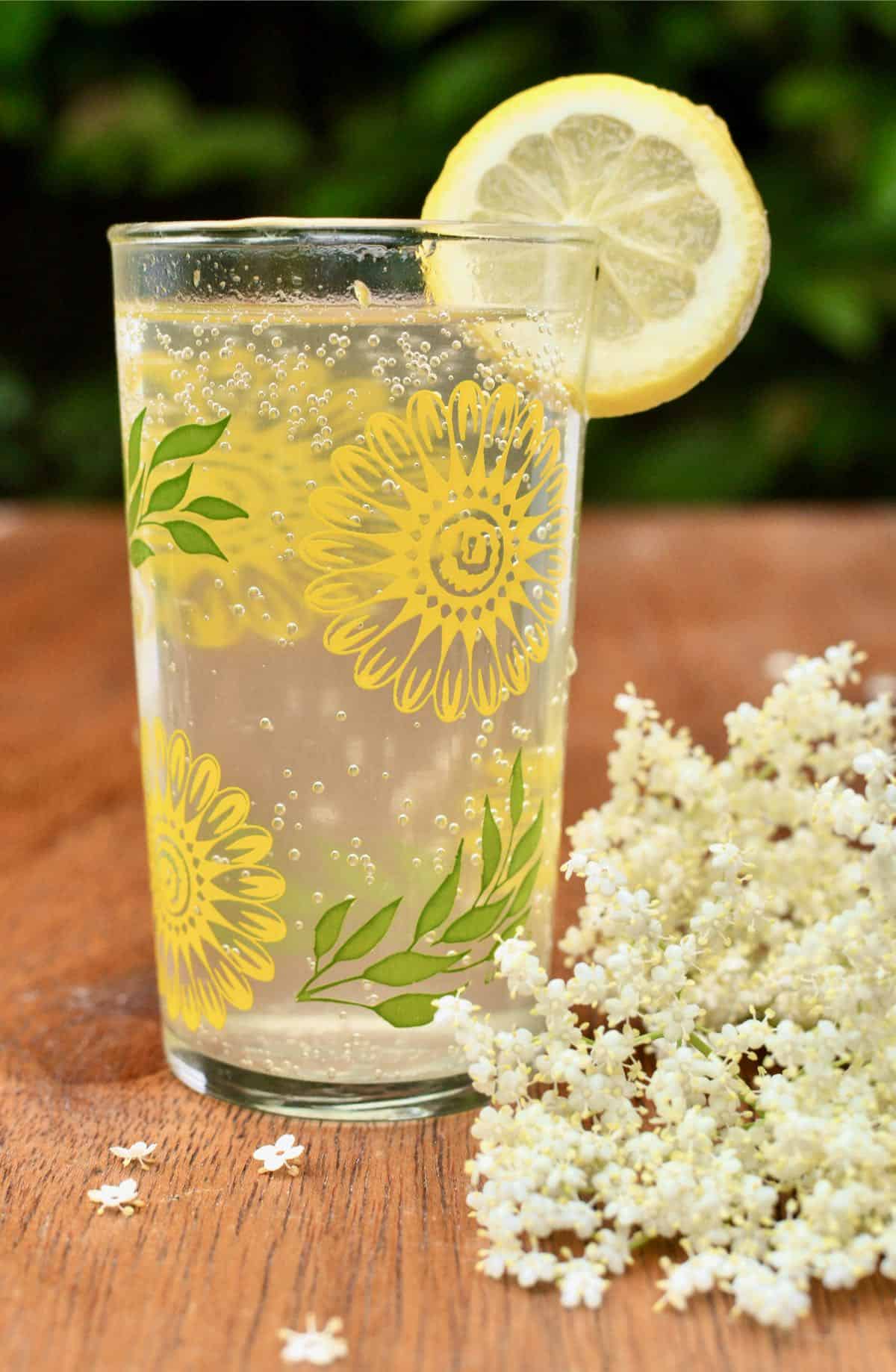How to Make Elderflower Cordial Without Citric Acid

The most refreshing drink. Ever! Heavenly flowery and tangy. Our homemade elderflower cordial is perfect with sparkling water on a summer day.

Every spring we make a huge batch of this elderflower cordial to last us the whole year. The ritual of picking elderflowers and filling the house (or our campervan) with their blossomy scent is a tradition that celebrates spring.
Homemade elderflower cordial is much tastier than store bought. This cordial is more tangy and floral, and less syrupy sweet. And it's such a fun thing to make. (It's always great fun to make things with edible flowers - like our vegan dandelion honey!)
Making your own cordial will save you a load of money too! In the UK, one 500ml bottle will set you back around £3, whereas making a batch of this cordial costs less than that - for 6 times as much!
Picking elderflowers
Elderflowers are the edible blossoms of the Elder tree, Sambucus nigra. This small tree is native to Europe and North America. It blossoms in late spring, and produces dark berries in late summer. Elderberries are also edible, but must be cooked before eating to get rid of toxins.

Here's our top tips for picking your own elderflowers:
- Avoid picking from roadsides and polluted areas
- Individual flower heads are at their prime for picking when the little flowers have fully opened and have not started to wilt or turn brown.
- The best time to pick elderflowers is late morning on a dry day.
- The flowers should smell blossomy and sweet - watch out for a slightly unpleasant aroma the flowers might develop in the afternoon, or when they are past their best.
- Always use them as soon as possible after picking.

Citric acid
Citric acid is a preservative and is naturally found in lemons and other citrus fruits. It brings a lot of tang! to the cordial and has a role in extracting the flavour from the elderflowers. It's also what helps the cordial to preserve for so long.
Where to get citric acid
It can sometimes be a bit tricky to find – pharmacies and world food shops are a good place to look. Our local zero waste shop sells it, so we buy it from them. It's also easily ordered online, just look for food grade quality. We recommend organic citric acid which is GMO free.
Making cordial without citric acid
It is possible to make this elderflower cordial without the citric acid, but the taste will be different and the cordial won't keep so well. If you omit the citric acid, store the finished cordial in the fridge and use up within a few weeks. You can also freeze it in plastic bottles so there's room for expansion, or in ice cube trays.
But if you can, we highly recommend using the citric acid in this recipe. To us, it makes all the difference!

Step by step

STEP 1 - Add water, elderflowers, sliced lemons and citric acid to a pan and bring to boiling point.

STEP 2 - Remove from heat and leave to infuse for a few hours or overnight.

STEP 3 - Strain the liquid through a muslin cloth or fine sieve.

STEP 4 - Return the liquid to the pan and add the sugar.

STEP 5 - Bring to boil, stirring frequently to dissolve the sugar. Simmer for 5 minutes.

STEP 6 - Fill the cordial into clean, sterilised bottles while still hot.

Preserving and storage tips
Here's our advice for how to make sure your elderflower cordial will keep well:
- The final boiling step sterilises the cordial by killing off any wild yeasts, bacteria or spores that will cause it to spoil.
- Clean all your glass bottles, lids and other equipment in soapy water or in the dishwasher, then fill with boiling water. Leave for 5 minutes before draining.
- Alternatively, place the washed bottles and lids in an oven at 140˚C until dry.
- Fill your bottles and put on the lids as soon as you finish simmering and the cordial is still hot. (Wear oven gloves as the bottles and lids will get hot!)
- Bottling whilst hot ensures that the lid seals as the liquid cools.
Store unopened bottles of cordial in a cool and dark place. After opening, keep in the fridge.
More tasty elderflower recipes
Our homemade elderflower cordial makes a perfect summer drink when mixed with cold sparkling mineral water. It also adds a fresh and fruity note to a glass of wine, champagne or a cocktail.

But you can use elderflower cordial for other things than just drinks... Try our other elderflower recipes:
Elderflower Cake
Elderflower and Coconut Ice Cream
Elderflower and Lemon Ice Lollies
Elderflower Fritters
Enjoy the summer!
Paul & Sophie

Easy Elderflower Cordial
Tangy and refreshing, simple. Summer in a glass. The best elderflower cordial recipe!
Prep Time 10 mins
Cook Time 30 mins
Resting Time 12 hrs
Total Time 12 hrs 40 mins
Course Drinks
Cuisine British, Traditional
Servings 3 Litres cordial
Calories 41 kcal
- 15 elderflower heads large (use double if small)
- 2 lemons sliced
- ¼ cup (50 g) citric acid
- 2 ½ litres (2.5 litres) water
- 5 cups (1 kg) sugar
Prevent your screen from going dark
-
Check elderflowers for dirt and little insects - don't wash!
-
Add elderflowers, lemon slices and citric acid to the water in a big pan. (The only ingredient not yet going in is the sugar)
-
Heat up to boiling point, stirring occasionally, remove from heat, cover and let infuse overnight, or for at least four hours.
-
Strain the liquid through a muslin cloth, to catch all the flowers. Squeeze all that yummy flavour out of the pulp in the muslin!
-
Return liquid to the pan and add the sugar.
-
Bring to boil again, stirring frequently to dissolve all the sugar, and simmer for 5 minutes.
-
In the meantime, sterilise some glass bottles (don't forget about the lids!) with boiling water. If you are going to use a funnel or any other pouring aid, sterilise that, too.
-
Bottle up the finished cordial while it's still boiling hot.
Dilution
-
Depending on desired sweetness, dilute 1:5 to 1:10.
-
Best enjoyed with sparkling mineral water.
-
Optional: Squeeze in some fresh lemon for extra tanginess!
See the post above for step by step images, and preserving tips.
Wondering where to get citric acid? We recommend ordering from Buy WholeFoods Online. Your local zero waste shop or pharmacy is also a good place to look.
Check out our guide to Elderflower Picking for helpful tips on getting the best flowers!
Recipe uses 15 large hand sized elderflowers. If you use small elderflower heads, just use two of them in place of one large.
Keep in a cool, dark place. Once opened store in the fridge.
Serving: 250 ml (ready diluted) | Calories: 41 kcal | Carbohydrates: 10 g | Protein: 1 g | Fat: 1 g | Saturated Fat: 1 g | Sodium: 1 mg | Potassium: 3 mg | Fiber: 1 g | Sugar: 10 g | Vitamin C: 1.2 mg | Calcium: 1 mg
Let us know how it was! Share a pic and tag @veganonboard - we love to see what you make!
How to Make Elderflower Cordial Without Citric Acid
Source: https://veganonboard.com/the-best-homemade-elderflower-cordial/